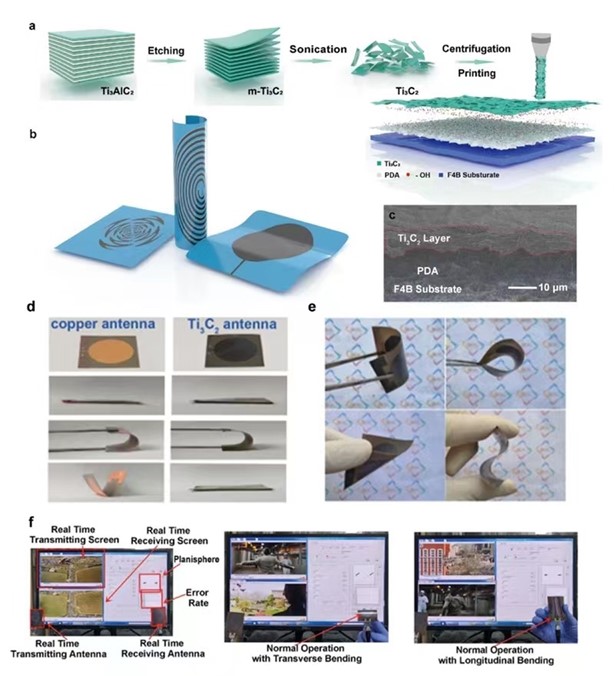Recently, the team of Academician Huang Wei and Professor Zhao Qiang from the State Key Laboratory of Organic Electronics and Information Display of Nanjing University of Posts and Telecommunications and the team of Professor Liu Leilei from the National and Local Joint Engineering Laboratory of RF Integration and Micro-assembly Technology have made important progress in the field of flexible RF antennas, optimized the strategy of combining “molecular glue” interface modification technology with advanced extrusion printing technology, and constructed a flexible ultra-wideband Ti3C2 monopole antenna, which realized smooth and real-time wireless communication transmission in a bending state. On January 17th, the related achievements were published in the international academic journal Nature Communications with the title of “2D Titanium Carbide Printed Flexible Ultra-wideband Monopole Antenna for Wireless Communications”. Nanjing University of Posts and Telecommunications is the only communication unit, Professor Liu Leilei, Professor Zhao Qiang and Academician Huang Wei are co-authors, and Associate Professor Zhao Wei and Dr. Ni Hao are co-first authors. This is an important research achievement achieved in the interdisciplinary field of “flexible electronics” by the cooperation of three superior disciplines in our university: materials, electronics and communication.
In recent years, with the rapid development of emerging technologies such as the Internet of Things, wearable devices and implantable electronics, flexible wireless communication devices have attracted extensive attention from academia and industry, and the demand for “light, thin and flexible” antenna components has increased rapidly. Traditional antennas are mostly composed of high-density metals, and their large mass and complex manufacturing process limit their application in the field of flexible wireless communication. In order to meet the rapid development of this field, the design and preparation of lightweight and conformal flexible RF antenna is the driving force for the sustainable development of wireless communication field and the key to this field.
Ti3C2 ink can be used as a common material in the fields of printing and patterning manufacturing due to its good hydrophilicity, easily adjustable rheological range and stable dispersion in various solvents. Two-dimensional Ti3C2 ultra-thin nano-material has the advantages of high conductivity, light weight, flexibility and easy processing, which is very suitable for the preparation and use of flexible wireless communication devices. However, at present, the research results of Ti3C2 antenna have some defects, such as limited structure, complex composition and rough production process, which greatly limit its application in the direction of flexible wireless communication devices. Therefore, simplifying antenna hierarchical structure, improving device fabrication accuracy and improving antenna flexibility and stability have become the key core issues to be solved urgently on the practical road of Ti3C2 flexible RF circuit.
In order to solve the problem that conformal integration of dielectric substrate and additive-free Ti3C2 ink is limited, this work puts forward a “molecular glue” interface modification process, which uses dopamine molecules to modify the flexible dielectric substrate, enhances the adhesive force between the printed Ti3C2 transmission layer and the surface of the dielectric substrate, and prepares a flexible ultra-wideband Ti3C2 monopole antenna with high spatial uniformity, achieving excellent bending stability and real-time information transmission effect. By changing the parameters such as ink concentration and printing layers, the transmission performance of the antenna can be further adjusted, and the controllable wireless information transmission function can be realized.
The development of Internet of Things system requires not only seamless integration between radio frequency circuit and antenna, but also communication between devices in a wide frequency band. The development of flexible Ti3C2 antenna will promote the rapid development of this field. The flexible ultra-wideband Ti3C2 monopole antenna prepared in this work works in the frequency band of 1.7 GHz-4.0 GHz, covering WLAN, Bluetooth and 5G (n41, n78) frequency bands, which is equivalent to the traditional Cu antenna and can transmit video signals completely, quickly and in real time. When switching between the bending state and the flat state, the bandwidth and central frequency of the Ti3C2 antenna can be well maintained, and the gain difference fluctuates around ±0.2 dBi in the low frequency range, which overcomes the shortcoming that the traditional Cu antenna has no resilience. The excellent cyclic bending stability of Ti3C2 antenna ensures smooth and real-time data transmission in flexible bending state, which is also the first example of wireless video transmission of Ti3C2 antenna. When the antenna is out of sight or in different azimuth angles, the transmission effect is still stable. Furthermore, the macroscopic electromagnetic characteristics of flexible ultra-wideband Ti3C2 monopole antenna are analyzed by combining simulation design, and the combination of material system and full-wave simulation and the accurate prediction of antenna performance are realized. The research results also have broad application prospects in many scenarios, such as human-computer interaction, Internet of Things, mobile communication system, big data transmission, video call, multi-person online conference, and information exchange with large amount of data.
This work is supported by the National Science Foundation for Distinguished Young Scholars, the National Basic Science Center Project and the General Project of the National Natural Science Foundation, and supported and helped by Professor Tian Feng, the Key Laboratory of Broadband Wireless Communication and Sensor Network Technology of the Ministry of Education.

Application of flexible ultra-wideband Ti3C2 monopole antenna in wireless communication field
(Writers: Zhao Weiwei and Liu Leilei Preliminary Reviewers: Zhao Qiang and Dai Xiubin Editor: Wang Cunhong Final Reviewer: Zhang Feng)



